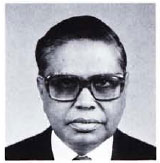- Volume 60 , Number 1
- Page: 109
Roy Handel Thangaraj march 21, 1930-july 29, 1991

Roy Handel Thangaraj was the son of Dr. Roy Sudarsanarao, who died in service while in charge of the old Philadelphia Leprosy Home and Hospital about 3 km from the village of Salur, in North Andhra Pradesh.
I visited the "home" in the late 1950s. It was beautifully situated, nestling at the foot of the Eastern Ghats and surrounded by densely wooded rocky hills. There were several tile-roofed wards full of patients, and most of them had white ants in the roof. Some of the other wards were in disuse because the roofs had already caved in. The only good building left was the rather imposing church of German Lutheran architecture. The grounds were neglected and overgrown with luxuriant waist-high undergrowth. There were not enough ablebodied patients to keep up with the earth's fertility, but there were still plenty to fill the few remaining reasonably safe wards, and the area was highly endemic for leprosy. Thanga was born in the home of his parents there in 1930, while the "home" was still under the care of missionaries. He imbibed leprosy from his very childhood-it was his home environment.
Dr. Thangaraj studied medicine in the Christian Medical College at Vellore. It was at the time when Dr. Cochrane was Director and Dr. Herbert Gass and Dr. Paul Brand were also in their prime of life and professional enthusiasm for leprosy care. His first assignment after graduation was to the newly opened sanatorium at Karigiri. We learned our leprosy together at the feet of these great masters-Cochrane, Gass, Brand.
He was then asked by The Leprosy Mission (TLM) to develop the surgical program at Purulia. Purulia was a good center but in a different language area and far away. He worked there for three years before being sent to the U.K. for special training in hand and plastic surgery.
Returning after a few years, he was assigned to develop the old dilapidated leprosy home at Salur, his ancestral village. With characteristic zeal and vision he proceeded to develop that center. He was responsible for planning, constructing and running an excellently equipped new general hospital which included reconstructive surgery, a leprosy control program, and a training program. The derelict old "home" was transformed into one of the leading leprosy centers in the East. The termite-riddled cottages were replaced with modern concrete and steel wards.
Then he was called to Delhi to the post of TLM Secretary for India, later widened and redesignated Director for Southern Asia. He was responsible for all of the centers in India, and also in the neighboring countries of Bangladesh, Bhutan, Nepal, Burma, and Sri Lanka. He collaborated with the governments of these countries in their programs and advised many of them, forging an enduring link among these governments, The Leprosy Mission, and other voluntary agencies. The high point in his career was the organizing of the International Leprosy Congress in 1984 which was attended by 1500 delegates from all over the world. At this meeting he was elected Secretary of the International Leprosy Association.
Dr. Thangaraj was a man of dynamism and zeal, an indefatigable worker, immersed in his vocation and not knowing the meaning of the word rest!
He leaves behind his wife Sarojini (also a tireless co-worker), two sons, and a daughter-all doctors and all deeply implanted with the same bent toward leprosy work. His greatest memorial is made visible in the work of the centers of excellence in leprosy scattered around India and its littoral countries.
His body rests in the grounds of the hospital he created at Salur. His spirit goes on in the activities of The Leprosy Mission all over Southern Asia.
- Ernest Fritschi